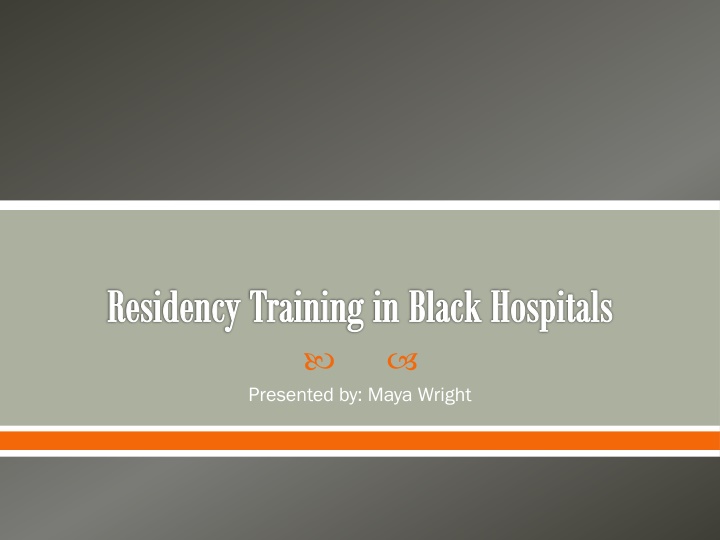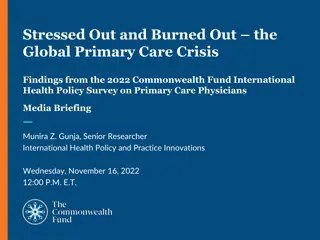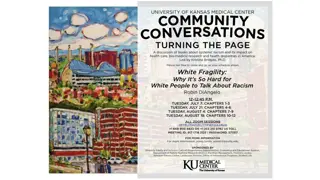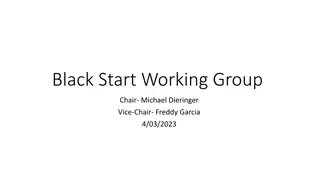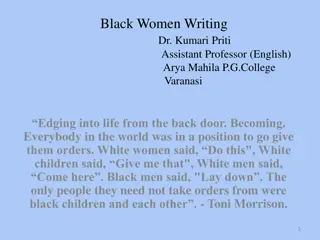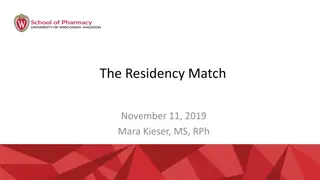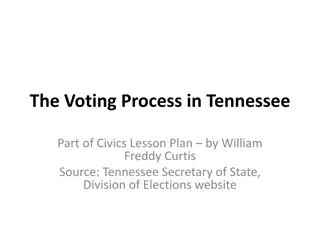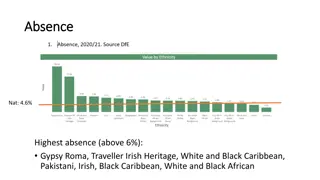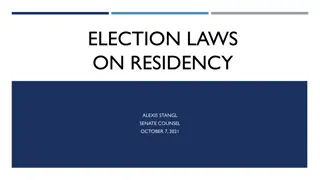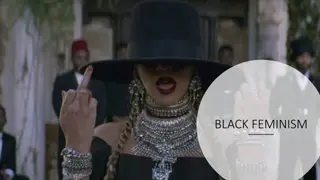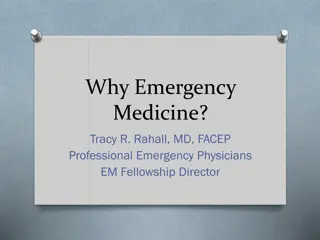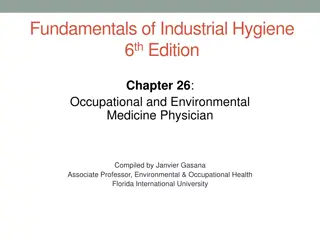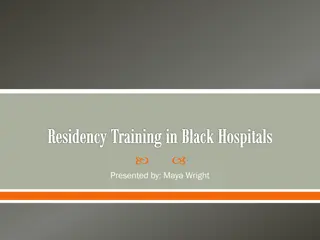Challenges Faced by Black Physicians in Residency Training at White Hospitals
The history of residency training for Black physicians in white hospitals reveals significant challenges such as limited opportunities, racial discrimination, financial constraints, and distrust in the medical community. From the lack of available residencies to financial struggles and the inability to gain equal footing in medical associations, Black physicians encountered major setbacks and obstacles that affected their professional advancement.
Download Presentation

Please find below an Image/Link to download the presentation.
The content on the website is provided AS IS for your information and personal use only. It may not be sold, licensed, or shared on other websites without obtaining consent from the author.If you encounter any issues during the download, it is possible that the publisher has removed the file from their server.
You are allowed to download the files provided on this website for personal or commercial use, subject to the condition that they are used lawfully. All files are the property of their respective owners.
The content on the website is provided AS IS for your information and personal use only. It may not be sold, licensed, or shared on other websites without obtaining consent from the author.
E N D
Presentation Transcript
Residency Training in Black Hospitals Presented by: Maya Wright
Race Relations White hospitals did not take on Black residents o In 1930 no residencies available to African Americans in any specialty field (60) o 1939 - fewer than 25 Black specialists Most Blacks excluded from residency programs before the 1950s (72) o 1947 - 18 out of 18,000 board certified specialists were Black o In many hospitals in the north, Black nurses and patients were allowed, but not doctors o People did not want Black men working over white nurses or operating on white people especially white women https://1e26550c-a-62cb3a1a-s- sites.googlegroups.com/site/earlyblackdocsalabama/Home/New%20Picture.png?attachauth=ANoY7crHpgo1orVuJGaDOL6cA__b _fyly0lC8xQl4eENq3lefpIKbf8ERl_UlEku6Eifv7Xhwn0mm0pg5pgxrsLc6RP9X3yZcDUNKGnbqXiiccNa8A2nsiSqEH3z6OkXSo5JPzHq XSt8Xrs-vNEIE9bsAIw2NPNbfj1X2QeP6p6tIBdoRst7JxBmXFr1zB9vuRY841k8K3exGA12FNp4LU-_-pT- 8hmjgocsl9Ci0hM90zBnvMlJAgM%3D&attredirects=0
Race Relations Inability to take boards o Blacks especially in the South not able to become members of American Medical Association Limitations on residency options o Some hospitals only offered certain specialties to Blacks that were sufficient for Black people Distrust in Medical Community o Because of lack of opportunities to continued education patients and white physicians believed Black physicians were not as qualified as white physicians http://www.mmc.edu/_resources/img/feature_wells_2012/aug_1/early_history_first_ operation2.jpg
Financial Support By 1958 there were adequate number of residencies available for Black physicians predominantly at white hospitals but Blacks chose not to attend because not paid enough o Many Blacks incurred debt during college and medical school and low paying residency was not a viable option Not financially viable in Jim Crow South o Many specialists denied hospital access o Tension with Black general practitioners who felt threatened and would not refer patients, would send them to white physicians o Potential patients could not afford specialty fees
Important Hospitals Freedmens Hospital, Washington DC o Daniel Hale Williams pioneered an internship program Kate B. Reynolds Hospital Winston-Salem North Carolina o Built from funds from Reynolds and Duke tobacco families o Provided internships for white and black physicians Harlem Hospital, New York Meharry Medical School Lincoln Hospital Durham North Carolina o Began training residents in surgery in 1948- close association with Duke medical school Homer G Phillips, St. Louis Missouri o 500 bed, staffed entirely by black physicians St. Mary s Infirmary, St. Louis, Missouri Freedmen s Hospital http://medicine.howard.edu/about/history/images/freedma n.gif
Influential Hospitals Wheatley-Provident Kansas City, Missouri Hubbard Hospital, Nashville Tennessee, Taborian Hospital Mound Bayou, Mississippi Harlem Hospital Harlem New York US Marine Hospital , Boston Massachusetts Provident Hospital, Chicago o One of the First hospitals to provide intern training for blacks Taborian Hospital http://misspreservation.files.wordpress.com/2010/06/file6876.jp g
Pioneers Dr. Daniel Hale Williams o Pioneered intern program at Freedmen s hospital which served as a model for other hospitals and helped to establish Washington DC as the center of the Black medical profession Dr. Matthew Walker of Meharry o Asked to be chief surgeon of Taborian hospital, turned the position down but implemented a plan that provided the hospital with surgical residents and interns from Meharry at a rotating basis o 2 residents served four to six months stints as chief surgeon and assistant and 24 meharry seniors served 2 week shifts as interns o Also trained locals to become medical technicians http://www.diversemedicine.org/wp- content/uploads/2012/11/daniel-hale- williams1.jpg?6db2c8
Pioneers Dr. John J Mullowne Meharry President o Proposed idea of selection one or two outstanding students to receive special training at a premier medical school or hospital under the understanding that they came back to teach at Meharry Dr. Numa P. Adams dean of Howard Medical School o Made a great effort to secure clinical specialists for Howard s faculty o Helped to make Washington DC center of black medical community o Also sparked national desire for more Black physicians to seek residency training http://lcweb2.loc.gov/service/pnp/hec/26800/26852 v.jpg
Institution Changers Dr. George Thorne o Sought admittance to the American College of Surgeons (ACS) did not put race on application but when the board found out he was black denied his application on grounds that that they were not conferring black members at that time o Caused a firestorm, prompted New York governor Thomas Dewy to investigate ACS s refusal to admit black surgeons o ACS quickly amended the policy, and stated black physicians did not need to be members of AMA if the region where the practiced excluded them o 14 black surgeons were soon after elected to the fellowship
Institution Changers Dr. Hubert Eaton o In 1957 rejected from American Academy of General Practice because he was black and not a member of AMA or its local chapter in North Carolina o Applied again in 1971 was again denied because he was not a part of AMA even though AMA now dropped racial bars Did not want to join because of the past discrimination he had experienced o Wrote to the American Academy of General Practice questioning is ethics and legality in denying southern black physicians o Soon after Academy amended to accept those who were members of NMA o Finally joined in 1972, 15 years later
Federal Government Intervention Hill-Burton (1946) o Legislation that provided millions of dollars in federal grants to states to build and improve hospitals on the condition that hospitals provided service without discrimination account to race creed or color Office of Economic Opportunity o helped to fund and Support Taborian Hospital and its residency and internship program in Mound Bayou Mississippi http://ncmuseumofhistory.org/exhibits/healthandhealing/elements/ media/topic-media/2_9_Wheres_the_Hospital_billboard.jpg
Philanthropy Rosenwald Fund o Helped fund countless black students, nurses, physicians, dentists, pharmacists through fellowships o More specifically provided the first 6 fellowships for Dr. Mullowney of Meharry s specialty training program Duke Endowment o Provided money to build black hospitals Rockefeller Foundation o Provided money to build black hospitals, and train black professions so that black community could be attended to and kept healthy and separated from white community http://www.seaconsortium.net/autopagev3/images/Thu May2007173757Rocke1.jpg
General Timeline 1919 Louis T Wright first black physician appointed to the medical staff 1926 First Black interns appointed 1934 Department of Surgery offers one-year surgical residency after externship o 1943 Louis T Wright appointed Director of Surgery o 1952 Aubrey de L. Maynard appointed Director of Surgery 1965 Urology Residency Training Program approved 1966 Orthopedic Residency Program approved http://www2.si.umich.edu/chico/Harlem/text/hospitalOUT_slide.html
Louis T Wright served as the crack in the door appointment through who other blacks were given a chance After appointment of black interns in 1926 racial tensions rose for the next several years o As a result of protest and persistent pressure from black physicians like Louis T wright the entire medical board and staff of Harlem Hospital was fired and new one appointed to replace them firing 23 white doctors and 2 black o 12 black doctors, 7 black in patient staff Physicians were assigned according to qualifications therefore making its mark in history as being the first American hospital to function with a racially integrated professional staff o As a result other hospitals in the area began to follow Harlem's example
In 1934 the first residency program was a one year program following and internship In 1945 Louis T Wright directed the new four year surgical residency program Later in 1953 the surgical residency program was increased to five years o In combination with New York University Postgraduate Medical school, residents would enroll annually in the post graduate course in surgery http://en.wikipedia.org/wiki/File:Archives_of_American_Art_-_Eric_Mose_-_2294.jpg
General Timeline 1919 City Hospital No. 2 opens 1927 City Hospital No. 2 receives approval for a surgery program from AMA 1937 New City Hospital N. 2 Opens and renamed Homer G Phillips http://www.flickriver.com/photos/jerkinhead/tags/hospital/
When City Hospital No. 2 opened, dedicated to the care of indigent black patients o Also an institution where black physicians could receive formal accredited postgraduate training, The only others during this time were Howard, Meharry, Harlem Hospital, and Provident Hospital Supervised by a white man o Black staff occupied associate staff members, functioned under the attending white staff no matter their qualifications The Peoples Hospital and St. Mary s infirmary were institutions that worked in conjunction with City Hospital No.2 and Homer G Phillips o People's Hospital would also take part in the surgical program in Homer Phillips Hospital Was integrated from it s inception, but predominantly black For many years the only place where black physicians ad surgeons could treat private patients in St. Louis http://www.blackpast.org/files/blackpast_images/o__St__Louis__Western_M anuscript_Collection_.jpg
Homer G Phillips Hospital's conception was a result of the dismal conditions of City Hospital No.2 o Opponents mainly white did not want the hospital to be built but instead wanted the money to be used to build an annex to City Hospital No.1 which was the white hospital o The argument being that annex would serve black patients o Homer Phillips the young black lawyer leading the drive for the establishment of the hospital wouldn t budge understanding that if the annex was created instead black physicians would not have the opportunity to practice or pursue post graduate education o Homer G Phillips Hospital was successfully opened in 1937 http://s3.amazonaws.com/findagrave/photos/2002/283/5606_10 34359825.gif
Homer G Phillips Hospital o Physicians were able to treat patients regardless of the race and supervision of white physicians was no longer required Residencies offered included gynecology and obstetrics, orthopedics, urology, otolaryngology, internal medicine, pediatrics, and surgery o Training in surgical subspecialties were part of general surgery service o General surgical residents were responsible for the care of patients who needed subspecialty surgical care Homer G Phillips also worked closely with Washing University Hospital http://image0- rubylane.s3.amazonaws.com/shops/20thcenturylostandfound/194 .1L.jpg
Reference Ward, Thomas J. "Post Graduate Education." Black Physicians in the Jim Crow South. Fayetteville: University of Arkansas, 2003. 59-93. Print. Organ, Claude H., and Margaret M. Kosiba. A Century of Black Surgeons: The U.S.A. Experience. Norman, OK: Transcript, 1987. Print.
